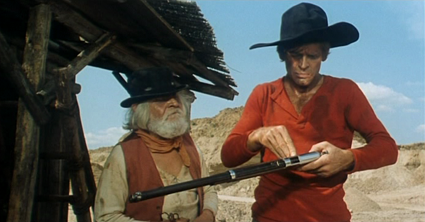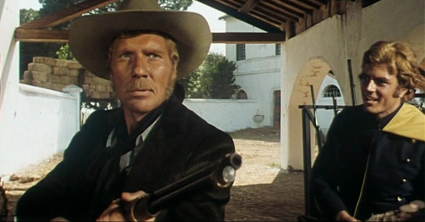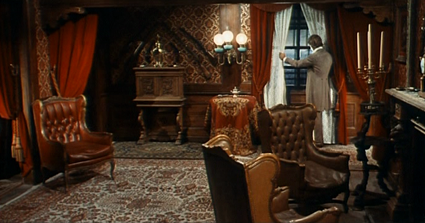And God Said to Cain review by Len: Difference between revisions
(Created page with "Review of And God Said to Cain (1970) aka E Dio disse a Caino Antonio Margheriti (as Anthony Dawson) directed and co-wrote this gothic horror tinged western where everybo...") |
(No difference)
|
Revision as of 08:54, 2 September 2019
Review of And God Said to Cain (1970) aka E Dio disse a Caino
Antonio Margheriti (as Anthony Dawson) directed and co-wrote this gothic horror tinged western where everybody's favorite mad genius, Klaus Kinski gets a rare chance to play the lead hero. The best way to see this classic in English is via the "Franco Cleef" fan dubbed DVDR, although the film can also be found on public domain budget sets, such as the Spaghetti Western collection from Popflix/Allegro, although I'm unsure as to the quality of the print.
Kinski gets reaquainted with his rifle.
THE PLOT
Nothing too original or groundbreaking here. Kinski's character, Gary Hamilton has spent the last 10 years toiling away in a hard labor prison camp for a crime he didn't commit. He receives a pardon in part because of his past distinguished military service. He has plenty of reasons to return home to seek revenge on the man who framed him as Acombar, the true culprit of the robbery that Hamilton was framed for, now lives in Hamilton's home, has taken over all of Hamilton's assets, and even lives with Hamilton's wife (who was in on the frame-up). Oh the things some people will do for love! For Hamilton, getting revenge won't be easy however. Acombar is now a super-wealthy land baron with political aspirations and some 30 hired guns on his payroll. Fortunately, Hamilton still has a few friends in town who know the truth and are willing to help him in any way they can. Hamilton also uses the cover of night and the threatening tornado warning to pick off the enemy gunmen one by one. The plot is revenge driven, simple, and effective. Despite the English title, the story has little to do with the biblical tale. Interestingly enough, the names "Gary Hamilton" as well as "Acombar" were used in another totally unrelated Spaghetti Western, A Stranger in Paso Bravo (1968).
"Nice shootin' dad."
THE PLAYERS
Kinski appeared in quite a few Spaghetti Westerns in his day, but usually in a small supporting role as a quick-to-be-killed villain. Kinski fans consider themselves lucky if they see Kinski on screen for more than 10 minutes. And this is why And God Said to Cain is something of a holy grail among Spaghetti Western aficionados, as Kinski not only gets screen time befitting a top billed leading man, but he also gets to play the good guy for once! Kinski's performance here is actually quite reserved, and sane. Indeed folks, Kinski doesn't go nuts in this one. Besides Kinski, the rest of the cast is serviceable. German actor Peter Carsten plays Acombar. His performance is hammy, but for a movie such as this, that's a good thing. Italian horror fans will be quick to recognize long time Margheriti collaborator Luciano Pigozzi (billed as Alan Cummings) as one of Acombar's men. Known as the "Italian Peter Lorre", Pigozzi worked with a venerable who's who of Italian Horror directors including Mario Bava, Sergio Martino, and Lucio Fulci. Antonio Cantafora, who some may recognize as the chief protagonist in Bava's Baron Blood (1972), plays Acombar's son.
Billy Joel, eat your heart out!
THE MOVIE
I must say, your interior designer did a helluva job with the place!
This is not a horror film. It's a western. Yet I can't help but get the feeling that fans of Italian gothic horror would get a better kick out of this film than a straight up Spaghetti Western fan would. Thus, I recommend that this film be viewed as a horror film, even though it isn't. Margheriti himself is no stranger to the gothic horror genre, having directed classics like Castle of Blood (1964), and ports over much of his familiar horror tinged atmosphere and tension. Windows suddenly blow open with the wind, strange sounds are heard…Klaus Kinski goes bump in the night. The pacing is terrific, as we get stretches of high strung tension interspersed with bursts of sudden violence. It is fun seeing Kinski sneak up on unsuspecting fools and dispatching them. Several times during the film, people are unintentionally shot and killed because they are mistaken for Kinski. Such is the power of one man to keep the whole town on edge. The main theme is corny, but overall, Carlo Savina's score adds wonderfully to the film's atmosphere. Margheriti directs with a style and resourcefulness that makes up for the shoddy production values. The film is not without flaws. The so called "Tornado" is nothing more than a strong wind. People's hats even stay on! There are the usual Spaghetti Western clichés such guns not running out of bullets. The dialogue can be horrible at times, but thankfully enough there isn't a lot of it. The climax is terrific, featuring a room full of mirrors and is reminiscent of films like Orson Welles' The Lady from Shanghai (1947), and the Bruce Lee vehicle Enter the Dragon (1973).
Tip of the day: When faced with 3 Kinski's, aim for the one in the middle!
THE VERDICT
As long as this film is viewed with the right mind set and expectations, it should be a treat for fans of Spaghetti Westerns, Italian gothic horror, and especially fans of Klaus Kinski. This is perhaps Kinski's finest hour in a Spaghetti Western outside of his roles in The Great Silence (1968) and A Bullet for the General (1966). Make sure to get a version with good picture quality, as inferior VHS transfers are very dark, making it especially hard to watch a movie that takes place primarily at night.
by Len Liu
This article is part of the A Fistful of Pasta archive








